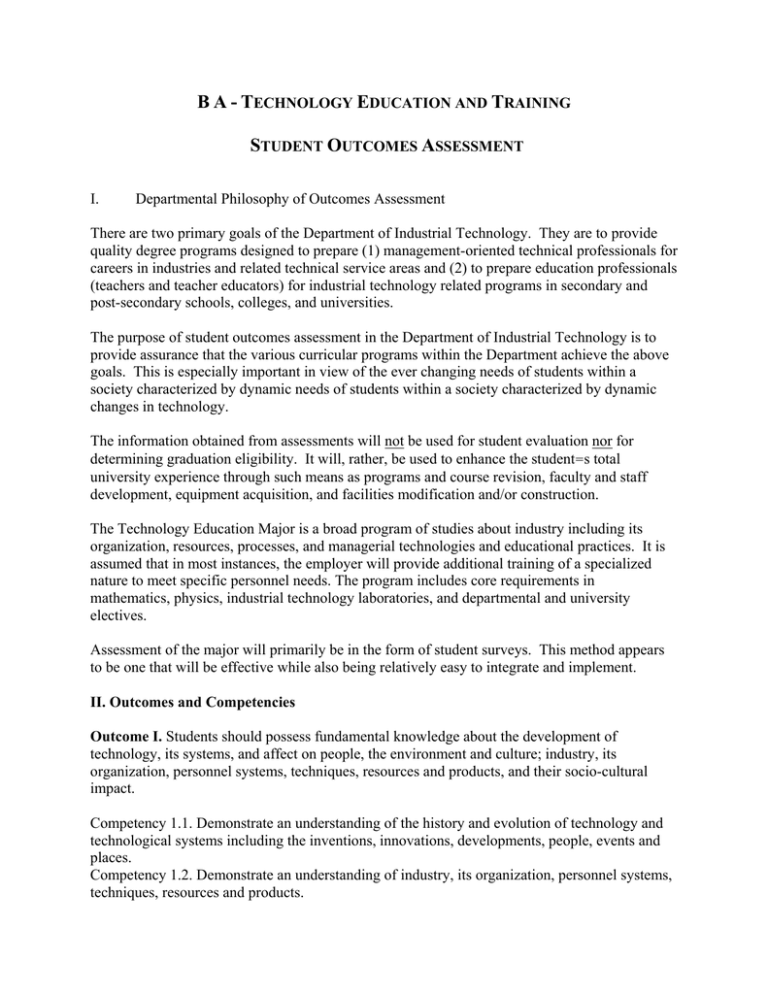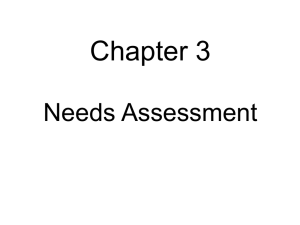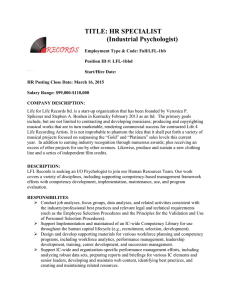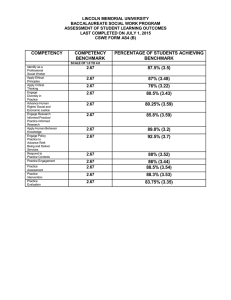B A - T
advertisement

B A - TECHNOLOGY EDUCATION AND TRAINING STUDENT OUTCOMES ASSESSMENT I. Departmental Philosophy of Outcomes Assessment There are two primary goals of the Department of Industrial Technology. They are to provide quality degree programs designed to prepare (1) management-oriented technical professionals for careers in industries and related technical service areas and (2) to prepare education professionals (teachers and teacher educators) for industrial technology related programs in secondary and post-secondary schools, colleges, and universities. The purpose of student outcomes assessment in the Department of Industrial Technology is to provide assurance that the various curricular programs within the Department achieve the above goals. This is especially important in view of the ever changing needs of students within a society characterized by dynamic needs of students within a society characterized by dynamic changes in technology. The information obtained from assessments will not be used for student evaluation nor for determining graduation eligibility. It will, rather, be used to enhance the student=s total university experience through such means as programs and course revision, faculty and staff development, equipment acquisition, and facilities modification and/or construction. The Technology Education Major is a broad program of studies about industry including its organization, resources, processes, and managerial technologies and educational practices. It is assumed that in most instances, the employer will provide additional training of a specialized nature to meet specific personnel needs. The program includes core requirements in mathematics, physics, industrial technology laboratories, and departmental and university electives. Assessment of the major will primarily be in the form of student surveys. This method appears to be one that will be effective while also being relatively easy to integrate and implement. II. Outcomes and Competencies Outcome I. Students should possess fundamental knowledge about the development of technology, its systems, and affect on people, the environment and culture; industry, its organization, personnel systems, techniques, resources and products, and their socio-cultural impact. Competency 1.1. Demonstrate an understanding of the history and evolution of technology and technological systems including the inventions, innovations, developments, people, events and places. Competency 1.2. Demonstrate an understanding of industry, its organization, personnel systems, techniques, resources and products. Competency 1.3. Describe selected socio-cultural impacts of technology and industry. Competency 1.4. Describe technology as a system with subsystems of communication, construction, energy/power/transportation, and manufacturing. Outcome II. Students should have a knowledge of the professional field of Technology Education. Competency 2.1. Describe the evolution of Technology Education and its relationship to Vocational Education and General Education. Competency 2.2. Identify the important elements of a contemporary Technology Education program. Competency 2.3. Identify and utilize relevant literature and professional organizations for Technology Education. Competency 2.4. Synthesize national and state legislation related to Technology Education. Outcome III. Students should have the technical competencies to teach Technology Education at the secondary level. Competency 3.1. Demonstrate skill and knowledge in communication technology processes. Competency 3.2. Demonstrate skill and knowledge in construction technology processes. Competency 3.3. Demonstrate skill and knowledge in manufacturing processes. Competency 3.4. Demonstrate skill and knowledge in energy/power/transportation processes. Competency 3.5. Exhibit safe practices when working with equipment and materials in the technology laboratory. Competency 3.6. Exhibit creativity and problem solving ability in laboratory activities. Outcome IV. Students have the knowledge and skills necessary to develop, manage, and evaluate Technology Education programs. Competency 4.1. Develop a rationale, mission statement, goals, scope and sequence, and program evaluation strategy for a Technology Education curriculum. Competency 4.2. Design a Course of Study, including a course description, goals and objectives, course outline, unit of instruction, and lesson plans. Competency 4.3. Plan an educational environment in the classroom and laboratory to facilitate the instructional process. Competency 4.4. Select appropriate instructional strategies for individual and group instruction/activities. Competency 4.5. Exhibit proficiency in designing a lab management system, including safety, inventory, filing, requisition of equipment and materials, maintenance, and budgeting. Competency 4.6. Develop a student management (behavior) strategy. Competency 4.7. Exhibit the application of other areas of knowledge (e.g. math, science, and history) in the Technology Education program. Competency 4.8. Describe the benefits of student organizations in the Technology Education class. Competency 4.9. Identify and describe strategies for program evaluation, including internal and external review methods. Outcome V. Students should exhibit instructional delivery skills appropriate for a Technology Education program. Competency 5.1. Demonstrate proficiency in planning and presenting both lectures and demonstrations. Competency 5.2. Demonstrate proficiency in presenting psychomotor, affective, and cognitive instruction. Competency 5.3. Demonstrate appropriate methods for delivering individual and group instruction, including problem-solving. III. Frequency of Assessments Assessments will occur at four times. These will be (1) Program entry (or in 330:019 Introduction to Technology Education); (2) mid-program (when a student has attained 44 credit hours in the major, or in 330:120 Technology Education Curriculum Planning, or 330:190 Methods of Teaching Technology Education); (3) near the end of the program (in 330:195 Managing Technology Education Programs); and (4) within five years after graduation. IV. Methods of Assessment The primary mechanism for conducting assessments will be the student survey. The methodology used is listed below. 1. Program entry: Students in 330:019 will complete a Technology Education Outcomes Survey, on which students will rate their level of knowledge regarding outcomes in the major. General questions will also be asked on the survey, including their career plans and special assistance needs. 2. Mid-Program: Students in 330:120 or 330:190 will complete the same survey used previously in 330:019. 3. Near program=s End: Students will complete a survey in 330:195. The general questions asked on the survey previously will be replaced by questions regarding the importance of various courses for employment and advancement, and strengths and weaknesses of the major. 4. Within Five Years After Graduation: A survey will be mailed to all graduates seeking their input regarding strengths and weaknesses of the major, as well as other coursework taken at UNI. V. Analysis-Interpretation and Reporting of Results The Technology Education faculty will review the survey results during the spring semester of each year and prepare a report which summarizes the extent to which competencies and outcomes are being realized. The faculty will also evaluate the assessment process and recommend changes as well as summarizing other information collected. The report will be presented to the Department Head for appropriate distribution. The faculty will use the reports to make adjustments in the assessment plan and to guide upcoming curricular revisions. Subsequent reports (assuming continued and expanded use of assessment portfolios) will be used to prepare normal five year program reviews and strategic planning updates for the department.





